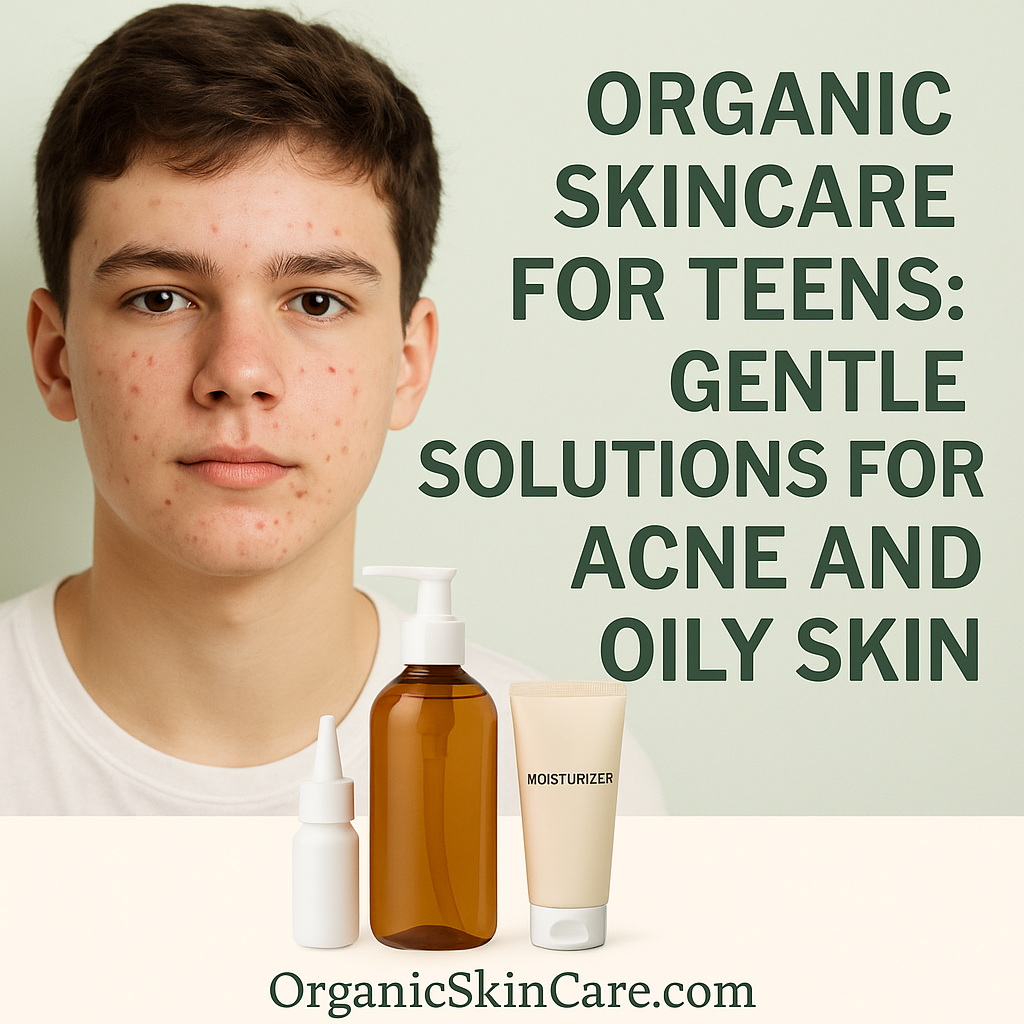Organic Skin Care for Teens | Gentle Solutions for Acne and Oily Skin
A teenager with acne on his forehead. Most teens experience some acne due to hormonal changes.
Is your skin constantly shiny by midday? Do new pimples seem to pop up right before school picture day? If so, you’re not alone. Acne and oily skin are extremely common in adolescence – in fact, about 85% of people between 12 and 24 experience breakouts. During puberty, your body’s changing hormones (especially androgens) trigger your oil glands to produce more sebum (oil). This excess oil, combined with dead skin cells, can clog pores and create an inviting environment for acne bacteria, leading to blackheads, whiteheads, and zits. The result? Stubborn teenage acne.
While drugstore shelves are full of harsh acne creams and strong astringents, those aren’t always the best choice for sensitive teen skin. Using products meant for adults – like high-strength retinol or gritty scrubs – can irritate and strip a teen’s delicate skin barrier, often making breakouts worse. The good news is that you can clear up acne and control oily shine with a gentle, natural approach. In this guide, we’ll show you how to build a simple teenage skincare routine (natural and effective) to treat teen acne naturally. We’ll cover the do’s and don’ts of caring for adolescent skin, and recommend some organic skincare solutions – including a few product picks from OrganicSkinCare.com – that are perfect for teens. Let’s get started on the path to clearer, healthier skin!
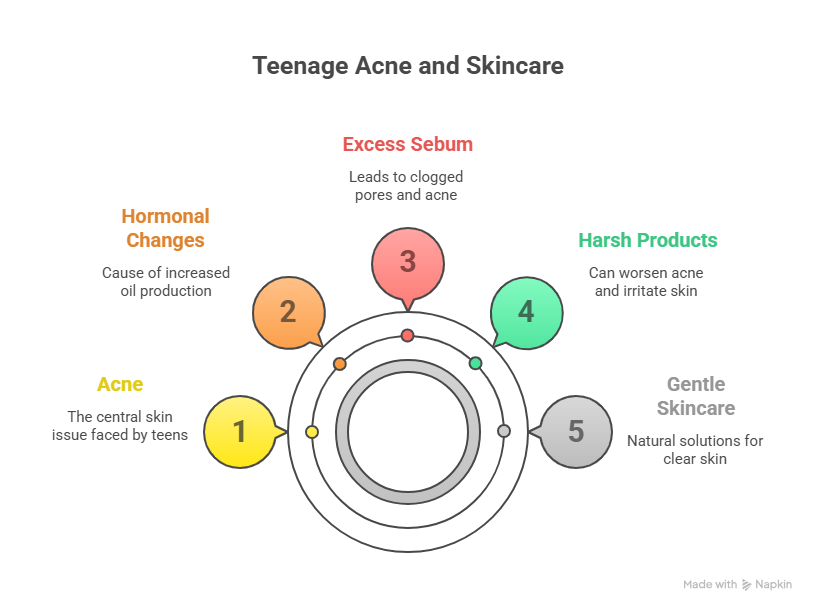
Why Teen Skin Needs a Gentle Approach
Teen skin is unique. During the teen years, surging hormones (like testosterone) send oil production into overdrive. That’s why teens often struggle with a persistently oily T-zone and frequent pimples. At the same time, adolescent skin can be sensitive and prone to irritation. Overzealous routines or harsh products can backfire by drying out or inflaming young skin. In response, the skin may produce even more oil to compensate, creating a vicious cycle of oiliness and breakouts.
Less is more when it comes to teen skincare. Dermatologists often recommend that teens stick to just 2-3 basic steps – typically cleansing, moisturizing, and sun protection – rather than complex 10-step regimens. A minimalist routine using non-toxic, age-appropriate products is key to managing oiliness while keeping the skin’s barrier organicskincare.com. Teens generally do not need potent anti-aging ingredients; in fact, heavy-duty products like strong retinoids, high-percentage acids, or alcohol-based toners can cause redness, peeling, and even more breakouts in young skin.
Instead, the focus should be on gentle solutions that address hormonal acne without aggression. That means:
Using mild cleansers to remove dirt and excess oil without over-drying.
Spot-treating pimples with natural antibacterials (like tea tree) or gentle exfoliants (like willow bark, a natural form of salicylic acid) instead of blasting the entire face with harsh chemicals.
Hydrating the skin with lightweight, non-comedogenic moisturizers that won’t clog pores – yes, even oily skin needs moisture!
Protecting young skin from sun damage with an oil-free SPF, since some acne treatments (and acne itself) can make skin more sun-sensitive.
By treating your skin kindly and working with its natural balance, you can gradually clear up acne and calm oiliness – all while avoiding the redness, stinging, and flakiness that harsher products often cause. You’ll build healthy habits that keep your complexion glowing now and set you up for beautiful skin in the future.
.
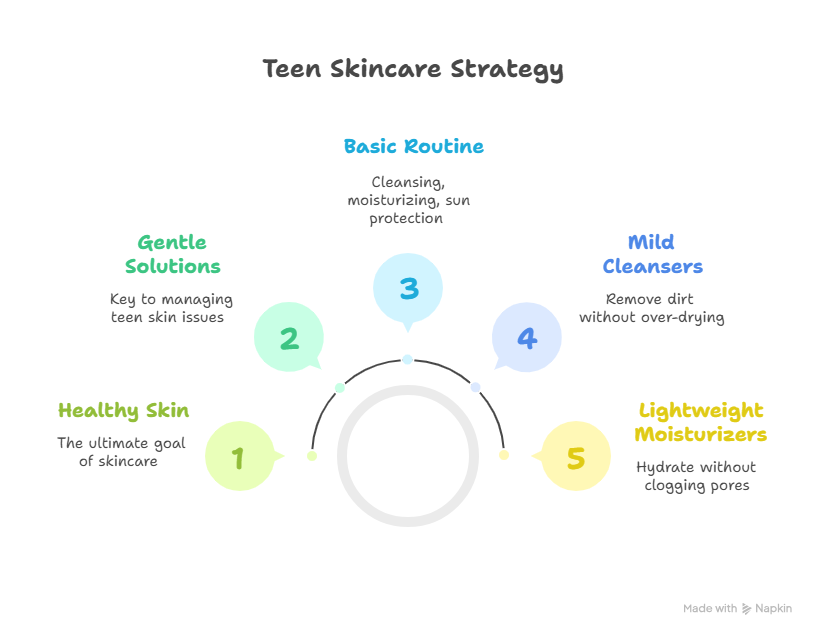
Gentle Steps to a Natural Teenage Skincare Routine
Achieving clearer skin doesn’t require a complicated routine or a cabinet full of products. In fact, the best approach for teens is a simple skincare routine that you can stick to consistently. Here’s a basic blueprint for a gentle, natural teen skincare regimen:
1. Cleanse With a Mild, Natural Face Wash
Cleansing is the foundation of any skincare routine. Throughout the day, your face accumulates sweat, oil, dirt, and (for some) makeup. Washing this away helps prevent clogged pores. But remember: keep it gentle. Avoid harsh soaps or high-strength acne cleansers that leave your skin “squeaky clean” (translation: stripped of all moisture). Over-cleansing can actually trigger more oil production and irritationwildrisingskincare.com.
Instead, look for a sulfate-free, natural cleanser with calming ingredients. For example, a lotion or gel cleanser containing aloe vera, chamomile, or green tea can soothe inflammation while cleansing. Tea tree oil is another great ingredient – it’s naturally antibacterial and is as effective as benzoyl peroxide for mild acne, but with fewer side effects like dryness. One popular option is a gentle tea tree face wash (such as Odylique Lemon & Tea Tree Facial Wash, which blends purifying tea tree with a mild, creamy base).
If you prefer an organic product, OrganicSkinCare.com offers the Ilike Lemon Cleansing Milk (part of the Ilike Organic Skin Care Balancing Set) – a hydrating cleanser that uses refreshing lemon and herbal oils to lift away dirt and excess oil without stripping your skin. Another teen-friendly cleanser is the Azulene Facial Cleansing Milk, which contains chamomile-derived azulene and panthenol to calm and cleanse sensitive skin, leaving it soft and clean. These kinds of products remove impurities while respecting your skin’s natural oils.
How and when to cleanse? Most teens do well with cleansing twice a day – once in the morning and once at night. Use lukewarm water (hot water can dry you out) and your fingertips to gently massage the cleanser on your face for about 60 seconds, then rinse. There’s no need for rough washcloths or cleansing brushes (in fact, scrubbing too hard is a don’t – it can irritate your skin). Simply pat dry with a clean towel. If you’ve been sweating from sports or PE class, it’s also a good idea to wash your face afterward with a gentle cleanser or even just water to refresh your skin.
2. Spot Treat Blemishes Naturally (Tea Tree & Willow Bark)
When a big pimple pops up, it’s tempting to douse your whole face in the strongest acne gel you can find. But blanket-covering your skin with harsh spot treatments can lead to dryness and flaky, irritated patches – not a good look. A smarter strategy is to target treat only the problem areas. Apply focused treatments on pimples or breakout-prone zones, and be kind to the rest of your skin.
For natural acne-fighting, two MVP ingredients are tea tree oil and willow bark (a natural source of salicylic acid):
Tea Tree Oil – This essential oil is a tried-and-true zit zapper. Thanks to its strong antiseptic properties, tea tree oil can kill acne-causing bacteria and reduce inflammation. In fact, research cited by the University of Maryland Medical Center found that a 5% tea tree oil gel worked as well as 5% benzoyl peroxide in treating acne, with fewer side effects. You can apply diluted tea tree oil as an on-the-spot treatment (pure 100% tea tree is very potent and may be too harsh on its own – a little goes a long way). Many natural acne products use tea tree oil in safe concentrations. For example, OrganicSkinCare.com carries a Tea Tree Oil Acne Scrub for gentle exfoliation, and an Acne Clearing Gel that likely features tea tree and other botanicals. Dab a bit of tea tree product on that pimple to disinfect and dry it out without burning your skin.
Willow Bark Extract – Meet nature’s version of salicylic acid. Willow bark is rich in salicin, which converts to salicylic acid and helps exfoliate inside the pores. It’s fantastic for clearing out clogged pores and reducing oil, but here’s the bonus: willow bark is much less irritating than synthetic salicylic acid, so it tends to be gentler on sensitive teen skin. It also has anti-inflammatory powers to soothe redness, greenpeople.co.uk. Look for natural spot treatments or serums containing willow bark extract – they will help speed up skin cell turnover, fight bacteria, and calm angry spots instead of making your whole face red. A great example is the Eminence Willow Bark Serum (if available) or other organic blemish serums that use willow bark to treat acne naturally.
Other botanical breakout-busters include witch hazel, a plant extract that acts as a natural astringent to tighten pores and tone down oil. Witch hazel can shrink the appearance of pores and reduce swelling of existing pimples – just ensure you choose an alcohol-free formula (pure witch hazel or ones with added alcohol can be too drying). Calendula and zinc are also excellent for spot-treating, as they help heal and reduce inflammation (some natural blemish creams use zinc oxide to dry out pimples overnight). One product to consider is a classic drying lotion – these often contain calamine, zinc, and sulfur to literally dry up a pimple by morning. For instance, OrganicSkinCare.com offers an Acne Drying Lotion that makes an effective overnight spot treatment for whiteheads. Use a clean cotton swab to dot these treatments only on active blemishes.
Important: Resist the urge to pick or pop your pimples! We know it’s hard, but picking can push bacteria deeper and cause more swelling, or even infection and scarring. It’s much better to treat the spot and let it heal. If you have a particularly painful cystic pimple, applying a warm (not hot) compress for a few minutes can help it come to a head, then treat and leave it alone.
3. Moisturize with a Lightweight, Non-Comedogenic Lotion
Ever felt like your skin is an oil slick and thought, Moisturizer? No thanks! You’re not alone – many teens with oily or acne-prone skin fear that moisturizers will make them break out more. But skipping moisturizer is actually counterproductive, even for oily skin. Here’s why: if you overly dry out your skin (say, by using strong acne cleansers and then not hydrating), your oil glands can go into overdrive trying to compensate, pumping out more oil to fix the dryness. The result is dehydrated and oilier skin at the same time. A good moisturizer keeps your skin’s moisture barrier happy, which can balance oil production in the long run.
The key is choosing the right type of moisturizer: go for a product that is “non-comedogenic” (meaning it won’t clog pores) and ideally oil-free or low in oils. Lotions or gels tend to be lighter than thick creams. Look for hydrating ingredients like hyaluronic acid (which attracts water to the skin), aloe vera, or glycerin, and soothing botanicals like cucumber or niacinamide. Avoid heavy oils unless they are known to be acne-friendly. One noteworthy oil is hemp seed oil – it’s high in linoleic acid and resembles the skin’s natural sebum, which can help regulate oil production rather than making skin greasier. Some natural acne formulas include a bit of hemp oil or jojoba oil for this reason.
For a great teen-friendly moisturizer, check out Emerge Labs Therapeutic Acne Moisturizing Cream on OrganicSkinCare.com. It’s a lightweight daily lotion formulated specifically for acne-prone skin (including teens) and packed with natural botanicals. It contains 2% salicylic acid to fight breakouts, but also has soothing plant extracts like tea tree oil and rosemary to prevent irritation or dryness. This combo means it can clear pores and treat acne while keeping your skin soft and calm. Users report it leaves the skin feeling balanced, not greasy or flaky. Another option is the Oil-Free Sebum Control Moisturizer, which, as the name suggests, hydrates skin while actively reducing excess oil in the T-zone by regulating sebum productionorganicskincare.com.
Apply your moisturizer after cleansing (and after any spot treatments), both in the morning and before bed. Use about a pea- to nickel-sized amount and gently massage it into your face (avoid the urge to rub aggressively). A good moisturizer will soak in without a heavy residue and will prep your skin so it doesn’t feel tight or look shiny. If you’re using any acne medications from a dermatologist, you can often layer a plain moisturizer on top to prevent dryness – just check with your doc.
4. Don’t Forget Sunscreen – Protect Your Skin Daily
You might think sunscreen is just for beach days or that it’s the last thing to worry about when dealing with acne. But daily SPF is a must for everyone – teens included! Not only do sunscreens guard your skin from harmful UV rays (preventing future wrinkles and reducing skin cancer risk), they also help keep acne from leaving long-lasting scars or dark marks. Sun exposure can darken post-acne spots (hyperpigmentation) and make them linger. Plus, if you’re using ingredients like salicylic acid, AHAs, or benzoyl peroxide, know that they can make your skin a bit more sun-sensitive.
Choose a broad-spectrum sunscreen SPF 30 or higher that is labeled oil-free, non-comedogenic or specifically “for face.” Many modern facial sunscreens are lightweight and won’t clog pores – some even have a matte finish to help with oil control. For example, mineral sunscreens with zinc oxide can be great for acne-prone skin (zinc is soothing and anti-inflammatory). Look for formulas that feel comfortable to wear daily. OrganicSkinCare.com carries Daily Defense Moisturizer SPF 30 with Azulene, which multitasks as a hydrating day cream and sun protector, containing calming azulene to keep skin from getting irritated. Applying an SPF moisturizer each morning will shield your skin and also keep your acne treatments effective (since unprotected sun can counteract progress).
Make sunscreen the final step each morning after moisturizing. And yes, even on cloudy days or if you’re mostly indoors, try to get in the habit of wearing at least a light sunscreen – incidental sun through windows or during recess can add up over time. Your future self will thank you!
5. Extra Credit: Weekly Treatments (Masks or Exfoliation)
This step is optional, but many teens like to use a weekly mask or gentle exfoliator to give their skin a boost. The trick is to pick something mild and not overdo it. Clay masks (like bentonite or kaolin clay) are awesome for oily skin because they absorb excess oil and can draw out impurities from pores. You might use a clay mask once a week on the T-zone to mattify and prevent blackheads. Look for ones with added calming ingredients (like a mask with charcoal + aloe, or clay + chamomile).
Another idea is using a natural exfoliator 1-2 times a week to help remove dead skin cells so they don’t clog pores. Avoid harsh grainy scrubs (like those with walnut shells) which can create micro-tears and irritate your skin. Instead, opt for gentle exfoliation: this could be a mild enzyme mask (using fruit enzymes or lactic acid from milk to dissolve dead skin), or a very gentle scrub with fine particles if your skin tolerates it. For instance, the Ilike Organic Skin Care Balancing Set mentioned earlier includes a Rosehip Exfoliator – a vitamin-rich clarifying mask that helps rid the skin of impurities and calm inflammation. Used twice a week, it can benefit acne-prone teenage skin by loosening dead cells and promoting new cell growth in a gentle organicskincare.com. Such treatments keep your complexion smooth and glowing, but won’t provoke breakouts when used properly.
After any exfoliating mask or treatment, remember to moisturize and, if it’s daytime, apply SPF before you head out.
By sticking to these core steps – cleanse, treat, moisturize, protect (and the occasional treat-your-skin mask) – you’ll develop a natural skincare routine that nurtures your skin. It may take a few weeks to start seeing improvement (patience is part of the process), but consistency pays off. Now, before we wrap up, let’s highlight some key do’s and don’ts for teen skincare to ensure you’re on the right track.
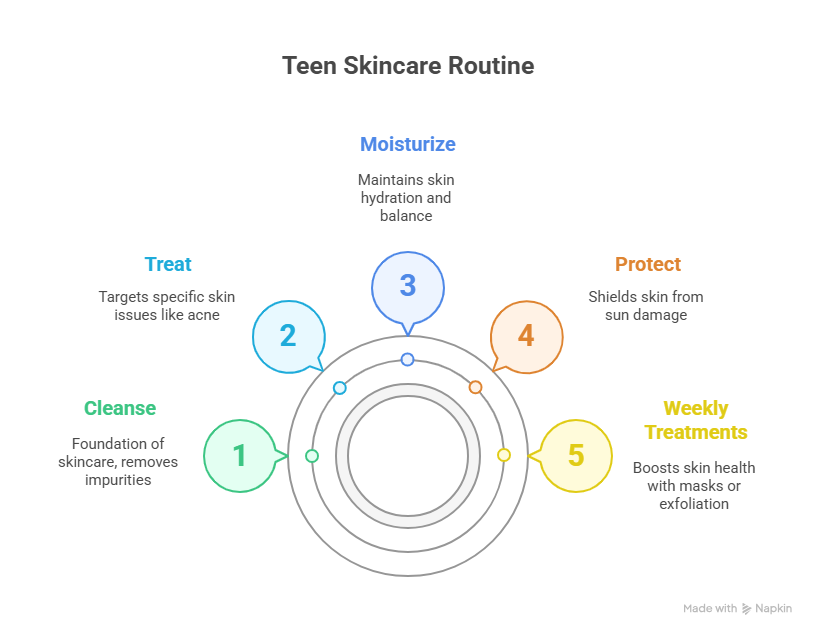
Do’s and Don’ts for Treating Teen Acne Naturally
Building good habits (and avoiding common mistakes) will make a huge difference in your skin’s health. Here are some friendly do’s and don’ts when dealing with acne and oily teen skin:
✅ Do: Keep It Simple and Consistent
Do stick to gentle products – Choose natural, fragrance-free cleansers and mild, non-comedogenic moisturizers formulated for sensitive or acne-prone skin. Products with fewer irritants (no strong perfumes or dyes) are less likely to upset your skin.
Do wash your face daily (but gently) – Cleanse once or twice a day (morning and night). Use a soft touch; think of cleansing as caressing your face, not scrubbing a pot. This removes grime and excess oil without damaging your skin’s barrier.
Do remove makeup before bed – If you wear makeup, take it off every night with a gentle cleanser or a micellar water. Sleeping in makeup can clog your pores and lead to breakouts.
Do moisturize and hydrate – Even oily skin benefits from light hydration. Keeping your skin properly moisturized prevents overproduction of sebum. And don’t forget to drink water throughout the day – staying hydrated from the inside can improve your skin’s overall health and help flush out toxins.
Do use sunscreen daily – As mentioned, a daily SPF 30 will protect your skin and help acne spots heal with less organicskincare.com. Many acne-friendly moisturizers include SPF, making it an easy step to remember.
Do spot-treat and be patient with pimples – Treat emerging zits with a targeted spot treatment (tea tree, a dab of benzoyl peroxide cream, etc.), then give it time to work. Big blemishes won’t vanish overnight, but they will heal faster if you refrain from picking. If a pimple is very swollen, you can also ice it for a few minutes to reduce inflammation. Patience and consistency are your friends – you may not see results from a new routine for several weeks, but steady improvement is the goal.
🚫 Don’t: Make These Common Skin Mistakes
Don’t over-cleanse or over-exfoliate – Washing your face too often or scrubbing too hard can strip away the healthy oils your skin needs. This can lead to dryness and trigger more oil production, actually worsening acne. Similarly, exfoliating aggressively or daily is a no-no; it can cause irritation and micro-cuts. Stick to mild exfoliation no more than 1-3 times a week, and avoid harsh scrubs with rough particles.
Don’t use harsh alcohol-based toners or wipes – Those classic astringent toners that sting (you know, the ones loaded with alcohol) might temporarily degrease your face, but they also dehydrate and irritate the skin. Drying out your skin too much prompts a rebound effect: your glands pump out even more oil to compensatewildrisingskincare.comwildrisingskincare.com. The result? A cycle of dryness and breakouts. Instead of alcohol-heavy toners or convenient makeup wipes (which often contain alcohol and leave residue), use a gentle toner or simply skip it. If you need a toner, choose one with calming ingredients like rose water or green tea, and absolutely no denatured alcohol high on the ingredient list.
Don’t pick, pop, or squeeze pimples – We’ve said it before but it bears repeating: picking at your pimples is likely to make things worse. Squeezing can push bacteria deeper and cause inflammation, potentially leading to infection or acne scars. It’s especially tempting with whiteheads, but try to use a drying spot treatment or see a professional for extractions if needed. Hands off for quicker healing!
Don’t share makeup, skincare, or brushes – It might be fun to try your friend’s new lip gloss or to share that concealer in class, but it’s not skin-friendly. Sharing products or tools can transfer bacteria and oil from one person’s skin to another, raising the risk of breakouts (or even infections). Keep your own set of clean makeup brushes and tools, and wash them regularly (dirty makeup brushes can breed acne-causing bacteria).
Don’t use “adult” anti-aging products on teen skin – Your mom’s retinol cream or your older sister’s strong acid peel pads are not meant for you. These potent products can be far too harsh for teenage skin, causing redness, peeling, or even burns. Experts advise that teens avoid intense ingredients like high-percentage retinol, glycolic or lactic acid peels, and concentrated vitamin C treatments, as these can strip and irritate young skinorganicskincare.com. Save the anti-wrinkle stuff for later in life – your teen skin just needs the basics: gentle cleansing, light moisture, and sun protection.
Don’t let stress or diet derail your skin – Okay, life as a teen can be stressful (exams, social drama, you name it), but finding healthy outlets for stress – like exercise, journaling, or talking to someone – can actually help your skin. High stress levels have been linked to acne flare-ups in some people. Also, while diet isn’t the main cause of acne, some studies suggest that consuming a lot of high-sugar foods or skim dairy might aggravate breakouts in susceptible individuals You don’t need to crash diet or cut out everything you love, but it’s wise to have a balanced diet (think fruits, veggies, lean proteins, whole grains) and moderate your sugary junk food intake. Your skin (and your overall health) will thank you.
By following these do’s and don’ts, you’ll avoid common pitfalls that can sabotage your skin-clearing efforts. Remember, teenage skin doesn’t need too much to be healthy – a gentle routine and good habits are usually enough to keep acne in check or at least minimize it. And don’t be discouraged by the occasional breakout; everyone gets them, and they often can be managed with the steps we’ve discussed.
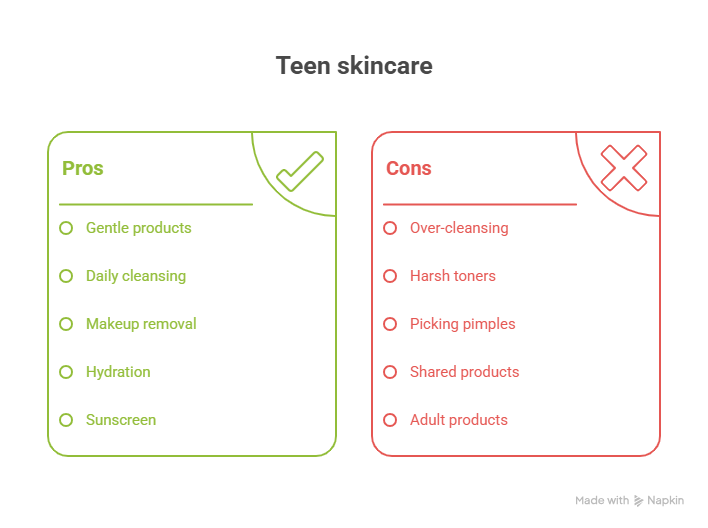
Embracing a Natural Skincare Journey
Starting a natural skincare routine – cleanse, treat, moisturize, and protect – can help teens manage acne without harsh chemicals.
Navigating acne and oily skin as a teen can feel frustrating, but remember that it’s a normal part of growing up for many. The key is to treat your skin with kindness. By opting for organic and natural skincare solutions, you reduce your exposure to potentially irritating chemicals and instead nourish your skin with gentle yet effective ingredients. Over time, these choices can lead to clearer skin and a happier you.
At OrganicSkinCare.com, we believe that teen skincare should be about supporting your skin, not fighting against it. Products like the Ilike Organic Skin Care Balancing Set (which cleanses, moisturizes and balances oily teenage skin) or the Emerge Labs Therapeutic Acne Moisturizer (packed with botanical extracts to combat acne while keeping skin soft) exemplify how natural ingredients can work in harmony with young skin. These gentle solutions help treat teen acne naturally – calming inflammation, keeping pores clear, and controlling shine without harsh side effects.
Finally, a gentle reminder: consistency is crucial. It might be tempting to skip routines when you’re tired or experiment with every new TikTok skincare hack, but sticking to a simple, proven regimen will serve you best in the long run. Give your skin time to adjust to a new routine (at least a few weeks) before judging results. And if your acne is severe or very persistent, it’s wise to talk to a parent or dermatologist – sometimes medical treatments are needed, and that’s okay. You can often combine dermatologist-recommended treatments with organic skincare (for example, using a prescribed acne medication along with a gentle organic cleanser and moisturizer to minimize irritation).
Healthy, clear skin is a journey, and you’re on the right path by focusing on gentle, natural care. With the tips, do’s and don’ts, and product suggestions in this guide, you have the tools to craft a teenage skincare routine that’s not only natural but also effective. Be patient and kind to yourself, and know that with consistent care, your skin can absolutely improve. Here’s to a fresh, confident face and embracing your natural glow!
Sources: The advice in this article is backed by dermatologists and reputable sources. For instance, Yale Medicine notes that acne affects about 85% of adolescentsyalemedicine.org, and hormonal changes during puberty drive excess oil productionyalemedicine.org. Experts emphasize gentle routines (just a few steps) for teen skin and caution against using harsh adult products on skin. Natural ingredients like willow bark and tea tree oil have been shown to fight acne effectively without the irritation of their synthetic counterparts. Harsh alcohol-based products can strip skin and lead to more oiliness so it’s best to avoid those drying “quick fixes.” The tips and product examples provided here align with these findings to ensure they are safe and suitable for teenage skin. With these gentle solutions, you can care for your skin in a way that’s healthy, organic, and teen-approved. Here’s to conquering acne the natural way!
Organic Skin Care for Teens | Gentle Solutions for Acne and Oily Skin Read More »

